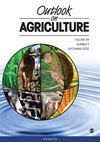农业生态学:在错误的地方寻找
IF 3.5
3区 经济学
Q1 AGRICULTURE, MULTIDISCIPLINARY
引用次数: 1
摘要
本文提出了对基于生态的垄断的辩护。“农业生态学”的推广已经被一种信念所证实,即自然植被在有害生物的压力下形成了多物种的“平衡”。农业生态学家认为单一栽培作物是自然界中未知的人工构造。为了实现这种生态平衡,作物田应该重新多样化,以物种多样化的“多元栽培”,作为自然植被的模拟。这种关于食草昆虫迫使植被多样性的简单观点直到1970年左右才被许多作者所接受。1970年后,人们对自然单优势植被的认识和关注日益增加。自然植物(尤其是草本植物)的单性优势背后的驱动力似乎是季节性生态胁迫,包括火灾、洪水、粉土形成和土壤养分缺乏。这些非生物的压力既能淘汰不太适应的物种,也能促进适应压力的进化(例如,在单优势红树林和海草的独特特征中可以看到)。结果是植物物种有能力以单一优势生长,但重要的是,进化出了抵抗来自食草动物的任何额外生物压力的能力——这两个特征对单一农业来说都是无价的。农业生态学从未考虑过适应生物压力的进化的可能性,以允许垄断(植物物种的“战斗”策略)。此外,农业生态学只承认短距离逃生的“飞行”策略(植物物种“隐藏”在混合物种植被中)。这忽略了现代农业的一个主要特征,它严重依赖于通过跨洋作物引进的远距离作物引进:通过远距离传播消除共同进化的草食性昆虫和疾病的易感物种的最终“飞行”机制。现行的农业生态学原理由于未能理解垄断的演变,在生态学上缺乏坚实的科学基础。我们仍有机会修正当前的思维,以发展一种更以生态为基础的农业生态学形式。本文章由计算机程序翻译,如有差异,请以英文原文为准。
Agroecology: Searching in the wrong place
This paper presents a defence of ecologically based monodominance. The promotion of ‘agroecology’ has been validated by the belief that natural vegetation forms a multi-species ‘balance’ under pest pressure. Agroecologists consider monoculture crops as an artificial construct unknown in nature. To achieve this ecological balance crop fields should be re-diversified to species-diverse ‘polycultures’, as mimics of natural vegetation. This simple view of herbivorous insects forcing vegetation diversity held sway with various authors until around 1970. Post-1970 there was an increasing recognition of, and focus on, natural monodominant vegetation. The driving force behind natural plant monodominance, especially in herbaceous species, seemed to be seasonal ecological stress, including fire, flood, silt formation and soil nutrient deficiency. These abiotic stresses were capable both of winnowing out less adapted species, but also encouraging the evolution of adaptations to the stress (as seen, for example, in the distinctive features of monodominant mangroves and sea-grasses). The result was plant species with the ability to grow as monodominants, but, importantly, the evolved ability to resist any extra biotic pressure from herbivores – both features invaluable for monoculture agriculture. Agroecology never considered the possibility of adaptative evolution to biotic stress to allow monodominance (the ‘fight’ stratagem of plant species). In addition, agroecology only recognizes the ‘flight’ stratagem for short-distance escape (plant species ‘hiding’ in mixed-species vegetation). This ignores a major feature of modern agriculture, which heavily relies on long-distant crop introduction, through trans-oceanic crop introduction: the ultimate ‘flight’ mechanism to remove susceptible species from co-evolved herbivorous insects and disease by long-distant dispersal. In failing to understand the evolution of monodominance, current agroecological principles are without a solid scientific basis ecologically. There is still an opportunity to revise the current thinking to develop a more ecologically-based form of agroecology.
求助全文
通过发布文献求助,成功后即可免费获取论文全文。
去求助
来源期刊

Outlook on Agriculture
农林科学-农业综合
CiteScore
5.60
自引率
13.30%
发文量
38
审稿时长
>36 weeks
期刊介绍:
Outlook on Agriculture is a peer reviewed journal, published quarterly, which welcomes original research papers, research notes, invited reviews and commentary for an international and interdisciplinary readership. Special attention is paid to agricultural policy, international trade in the agricultural sector, strategic developments in food production, the links between agricultural systems and food security, the role of agriculture in social and economic development, agriculture in developing countries and environmental issues, including natural resources for agriculture and climate impacts.
 求助内容:
求助内容: 应助结果提醒方式:
应助结果提醒方式:


